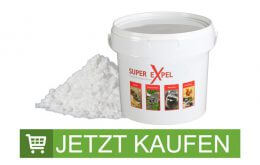Martens in the attic: How to get rid of the martens in the house
Consequences, signs and measures to combat 2017
The marten is a night-active carnivorous animal widespread in Central Europe with characteristically long stretched body and short limbs. It prefers to live near human settlements and searches for shelter and warmth in houses.
If a marten has nested itself in the attic , it causes enormous damage to the building, associated with high costs, which not only affects the rooms in which it is staying, but also the outer facade and the insulation of the roof overhang. Thus living with a stone marten becomes dangerous.
Tips for homeowners
Stone martens are excellent climbers who can jump over two metres and like to be high up on trees and buildings. They can easily reach a roof from a tree and use gutters or down pipes as supports. If the house wall is roughcast during construction, they don’t need any climbing aids for shorter distances because of their sharp claws and agile stature.
Once the marten has reached the roof, it can easily reach the inside of the house through the smallest openings. In order for a marten to find its way into the house, it can move a roof tile if no suitable hole is available. A marten in the roof has nested as a loner and predator, which reacts sensitively to disturbances, in an uninhabited room and remains there initially unnoticed.
Most people now come up with the idea of sealing the roof, this is absolutely the wrong approach.
Tips from our marten professional in the video
The marten in the house and the consequences for the inhabitants
At nightfall the marten leaves his hiding place to go hunting and brings back animal prey from his nightly rambles. These cadavers, like his excrements, are associated with considerable contamination of the premises. If a marten stays in the house, he uses a single place as a clean animal as a toilet.
Accumulated excrement and urine traces with the time on additionally an extreme odour nuisance exists which lead to a hygienic problem.
A marten , after some time, is recognized by the strict smell of faeces and decaying animal material. It leads the concerning to a substantial restriction of the quality of life.
The imported loot attracts maggots, flies and other pests. At the same time, the excrement that the marten leaves in the attic is a herd of pathogens that pose a great health risk to humans.
In addition to the formation of odours, the noise associated with the marten becomes a considerable nuisance for the inhabitants.
When the nocturnal animals return from their raids to their hiding places, strong noises are heard in the rooms below. This is due to the nibbling on objects and insulating material, which means that the early hours cannot be ignored. Thus the marten in the roof is connected in many aspects with a psychological and health load of the house-inhabitants.
How does a marten live at your house?
Martens are loners in principle and they mark and defend its precinct on the outermost. If the marten became native on the attic, then this ground belongs to it. In the winter, it seeks the proximity of the human being, here, it finds a food supply, that helps it over the winter. Garbage cans are also searched for food and plundered. Neighbour’s hens and their eggs arouse the interest of the marten and offer him a good food basis if he is not stopped. That a marten is in the house can be recognized by crawling noises as well as excrement and urine traces . Remains of his meals are signs that a marten has been accommodated in the house .
The marten in the garden
- The stone marten becomes a considerable hygiene pest, if it is on the property and goes there in the night on loot-raid. They eat rats, mice and other rodents and contribute to natural pest control.
- The animals become problematic if they stay regularly on the same property. Marten excrement in the garden, which accumulates in certain places like in the house, is disturbing for the garden owner.
- The germs that develop on the heaps of marten droppings in the garden and multiply rapidly can contaminate the soil. You can recognize the marten’s faeces by the fact that it is curled and consists of 50% grains of berries.
Expensive marten damage to house and car
Damages caused by a marten in the roof can fall back on the car. The animals tend to build whole tunnel systems in the roof insulation and to destroy underlays.
The associated formation of thermal bridges leads to rising heating costs and, in poorly heated rooms, to the escape of water and moulds. Martens do not belong for these reasons into the living range of humans.
Since the animals like to bite into power lines, it results in expensive damage to the electrical systems. Holes encourage water to enter the house from the outside via displaced roof tiles.
Once a marten has found its hiding place, the cable damage to the car becomes a considerable financial burden and is associated with a high safety risk.
It is important to take consequent measures of a professional marten defense against the first conspicuous traces on the property or in case of suspicions that a marten has settled in the roof, cellar or garage. Most household contents insurances take over the costs if this was correctly indicated with conclusion of a contract.
The marten is the marten’s biggest enemy, the animals are territory-oriented, which is the reason for many destructions at the car. In 2017 alone, over 27,000 marten damages were reported to vehicles in Germany. Many car owners decide to install an ultrasonic device, this has not yet been proven as a concrete solvent.
Martens in the roof, what to do?
Tips from the marten professional.
If a marten has taken over the attic, it will be difficult for the inhabitants of the house to get rid of it. This makes it all the more important to check all rooms during the breeding season, which in Central Europe lasts from March to late summer, and to ensure that marten droppings are not accumulated in the garden.
If the location of the animal in the house is known, targeted and consistent measures can drive the marten away.
It is important to disturb its rest period during the day by playing loud music. With ultrasonic devices and loud knocking a marten cannot be driven away. If a female marten nests in the roof, house and garden as hiding place to supply the brood, measures to the marten defence are gonna become quite difficult to free from the infestation.
From an abandoned hiding place a strong scent emanates which attracts conspecifics and therefore favours repopulation.
Since the animals in many European countries are subject to hunting law, they may only be removed by authorized specialists, this also applies to the capture or killing of the marten, a deterrence is excluded there.
In order to avoid costly damages, which the insurances take over to a small portion, with first assumptions that a Marten is in the roof , an expert should be contacted to the pest control .
In the course of the assessment, the expert will assess the extent of the infestation and immediately initiate targeted measures, and with an effective marten defense will be able to protect the house and property from a renewed infestation, the professionals are happy to decide for Superexpel.



